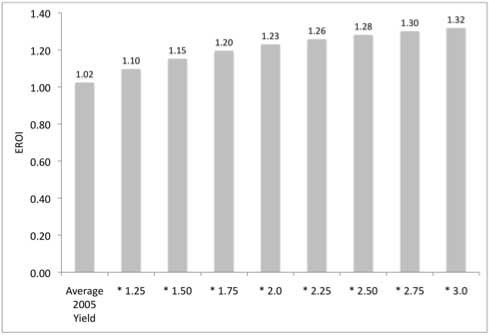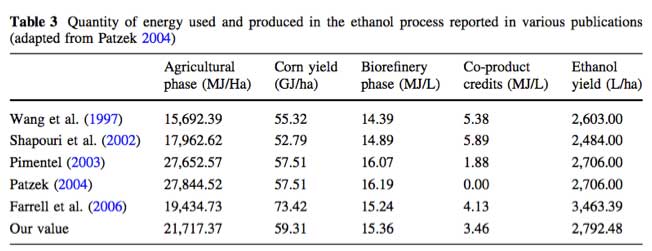New Perspectives On The Energy Return On (Energy) Investment (EROI) Of Corn Ethanol: part 2 of 2
By David Murphy
10 August, 2010
The Oil Drum: Net Energy
The following is the second of two posts based on a recent paper published under the same title in the journal Environment, Development, and Sustainability. I was the lead author for the article. The other two authors were Charles Hall and Bobby Powers. Part 1 of this series can be found at this link.
In the analysis underlying our paper "New Perspectives on the Energy Return on (Energy) Investment (EROI) of Corn Ethanol," we performed four major analyses relating to the EROI of corn ethanol. The first was a meta-error analysis, in which we quantified the error associated with the calculation of EROI of corn ethanol based on various estimates of the energy inputs and outputs found in the literature. The second was a spacial analysis of the EROI of corn ethanol. These two items were discussed in Part 1 of this series.
In this part, we will discuss a two additional research areas from the paper. These two additional research areas are:
> A sensitivity analysis, in which we assess the extent to which corn yields and co-product credits impact the EROI of corn ethanol.
> An assessment of how much net energy was delivered to society by ethanol in 2009.
We have also included our more general conclusions.
Sensitivity Analysis: Corn Yields
The assumption about increasing corn yields on the EROI of corn ethanol has resulted in much confusion. For example, Wang et al. (2007) report that yield levels could reach 11,000 Kg/ha (180 Bu/Ac) by 2015, which is roughly 25% higher than the average 2005 level. Yet they do not indicate how this will impact the EROI of corn ethanol or what increases in fertilizer, pesticides, etc. will be required to reach these elevated yield levels. Although it is clear that increasing corn yields will increase the gross output of corn per unit area, its effect on the EROI of the entire corn ethanol process is less clear because the corn itself becomes just one of many intermediate inputs. The effect of corn yields on EROI depends upon its fraction of the total energy input to corn ethanol production.
To address the impact of possible future higher yields on the EROI of corn ethanol, we calculated EROIs for various scenarios using yield levels that were up to three times greater than the average yield in 2005. We do not expect that average corn yields will reach a level three times greater than the 2005 average; rather we include them to serve as a theoretical maximum to show the trend in EROI given changes in yield. Although increasing yields would certainly require increases in the use of at least some fertilizers, lime, and/or irrigation, for simplicity’s sake, we increased yield levels only, keeping other numbers in the EROI calculation constant.
Increasing yield even far beyond the highest levels in 2005 had a trivial impact on the EROI of corn ethanol (Fig. 6). As a result, efficiency gains that occur post-farm gate only (such as the distillation or transportation processes) are able to increase the EROIRG (EROI "Refinery Gate") significantly. To that end, recent research by Liska et al. (2008) calculated the EROI of corn ethanol using various methods of distillation that utilized a variety of current technologies. They found that the EROI range for corn ethanol remained low, from 1.29–1.70 (we excluded two hypothetical scenarios that they also assessed). With the absence of technology to boost the efficiency of the distillation process and the trivial impact that increases in yield have on the EROI of corn ethanol, we conclude that there is no reason to expect that the EROI of corn ethanol will increase much beyond current levels in the foreseeable future.

Fig. 6. EROI as a function of increasing yield. Average 2005 yield (8795 Kg/Ha) was multiplied by the values listed across the x-axis for each respective calculation.
Sensitivity Analysis: Co-Product Credits
The debate over whether the co-products of ethanol production, e.g. Distiller’s Dry Grains, deserve an energy credit warrants exploration. On one side Patzek (2004) believes that the co-products must be returned to the field to replenish soil humus. On the other side Wang et al. (1997), Shapouri et al. (2002), Farrell et al. (2006), and Wang et al. (2007) consider the co-product a valuable output of the corn ethanol production process and assign it an energy credit. Unlike yield, the energy content of the co-products is added directly to the energy content of the ethanol in the calculation of EROI. As a result, energy credits for co-products can have a large impact on the EROI of corn ethanol. To address the concerns about the impacts of both yield increases and co-product credits on EROI, we performed a sensitivity analysis to gauge how EROI will change given changes in either input.
To assess how sensitive the calculation of EROI is to changes in co-product credits, we performed three calculations. We first calculated the EROILIT based on the average co-product credits calculated across all five studies (3.46 MJ/L). Then, we calculated the EROI without co-product credits, called the ‘‘Patzek Case.’’ Lastly, we calculated the EROI using a co-product credit of 5.89, called the ‘‘Shapouri Case.’’
EROI analysis is highly sensitive to co-product credits. When using the ‘‘Patzek Case’’ (energy credit = 0), the mean US EROI of corn ethanol decreases from 1.07 to 0.91, but when using the ‘‘Shapouri Case’’ (energy credit = 5.89), the EROI increases from 1.07 to 1.17. Thus, the co-product credit alone can determine whether the EROI is less than or greater than one. This contradicts Shapouri et al. (2002) who claimed that the EROI is greater than one before accounting for co-product credits. Using an alternative weighting mechanism, such as price, may ameliorate some of the sensitivity of the EROI statistic to co-product credits.
Fundamentally, the disagreement over the value of co-product credits hinges on one’s attitude toward the science of nutrient cycling and erosion. Those who believe that corn yields are maintained without spreading the nutrients contained in the co-products back onto the field will generally assign a co-product credit in the EROI calculation. Those who believe that the science is unclear will generally assign a conservative co-product credit or even omit the credit altogether. We believe that until a clear consensus emerges, the precautionary principle should apply, and one should be very cautious in assigning coproduct credits.

Table 3. Quantity of energy used and produced in the ethanol process reported in various publications (adapted from Patzek 2004).
Net Energy Returned to Society by Ethanol
As I wrote in this post, low EROI resources deliver a low amount of net energy to society because much of the energy extracted is required to run the energy extraction process. Comparing the gross energy produced from ethanol to that from gasoline is hence misleading. In the paragraph below we compare the net energy produced from ethanol to that produced from oil each year in the U.S.
The EROI values for counties with biorefineries ranged from 0.64 in Stark, North Dakota, to 1.18 in Phillips, Kansas. Our analysis of 127 biorefineries indicated that of 31.6 billion liters of ethanol produced in the United States, only 1.6 billion liters were net energy (roughly 5%). As a point of comparison, of the 136 billion liters of gasoline consumed in 2009, roughly 122 billion liters (90%) were net energy, assuming that the 136 billion liters were produced at an EROI of 10 (Cleveland 2005). Adjusting for the lower energy content of ethanol (21.46 MJ/L etoh vs. 34.56 MJ/L gasoline = 0.62), we calculated that the net energy from ethanol is roughly 0.99 billion ‘‘gasoline-equivalent’’ liters. Dividing the net energy supplied to society from ethanol by that from gasoline, we calculated that the supply of net energy to society from ethanol is only 0.8% of that from gasoline (0.99/122 = 0.8%). Thus comparing simply the gross production of gasoline- equivalent liters of both ethanol and gasoline is misleading, as one would conclude that the US production of ethanol is 14% of gasoline consumption (19.6/136 = 14%).
Conclusions
The debate over the EROI of corn ethanol has been concerned mostly with whether it is a net energy yielder. As such, the dialogue has veered away from many of the larger implications of EROI analyses. Our results indicate that the EROI of corn ethanol is statistically inseparable from one energy unit returned per energy unit invested, and it is likely that much of our ethanol production is acting as an energy sink, requiring more energy for production than that contained in the ethanol product. This conclusion was confirmed in our spatial analysis, where the average EROIRG was 0.06 lower than the average calculated from the literature.
Increasing yields is oft-touted as a way to increase the EROI of corn ethanol, but our analysis indicates that the gains in EROI are small even when the average yield from 2005 was tripled. Co-product credits, on the other hand, have a large influence on the EROI from corn ethanol. There is no consensus within the literature regarding an appropriate co-product value, and until one emerges (one way or another), we should err on the side of caution when applying credits to co-products. Finally, the analysis of ethanol production from biorefineries supports our conclusion from the spatial analysis: the EROI is too low in too many locations to make an impact on our gasoline consumption. Our best estimate is that the net energy provided from ethanol accounts for only 0.8% of the net energy provided by gasoline.
The evidence provided in this research is clear: we do not know the exact EROI of ethanol, but even if we are remotely close (± 0.2), we are still, in the best case scenario, gaining an insignificant amount of net energy. Furthermore, Hall et al. (2009) estimated that only fuels with an EROI greater than 3:1 provide the requisite net energy to provide a fuel source and to maintain the infrastructure associated with the current U.S. transportation system. Fuels that have an EROI below 3:1 require subsidies from other energy sources to pay for all of the infrastructure associated with the transportation system of the US. The EROI of corn ethanol that we calculated is lower than the 3:1 threshold, indicating that corn ethanol requires large subsidies from the general fossil fuel economy, and as a result, drains energy from the US transportation system.

